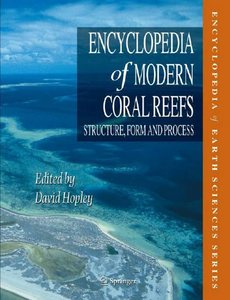Double and triple reef fronts
Hopley, David (2011) Double and triple reef fronts. In: Hopley, David, (ed.) Encyclopedia of Modern Coral Reefs: structure, form and process. Encyclopedia of Earth Science . Springer, Dordrecht, The Netherlands, pp. 325-326.
![[img]](https://researchonline.jcu.edu.au/19077/5.hassmallThumbnailVersion/19077_Hopley_2011_Book_Cover.jpg)
|
Image (JPEG) (Book Cover)
- Cover Image
Download (95kB) |
|
|
PDF (Published Version)
- Published Version
Restricted to Repository staff only |
Abstract
[Extract] The reef front is the windward margin of a coral reef with multiple fronts produced by narrower and younger sections of reef flat to windward of the main front.
The windward side of most reefs is formed by a straight edge or "hard line." Occasionally, however, there may be a second or third line of reefs separated from the main reef by linear lagoons up to 300 m wide and 10–30 m deep. Such features have been described in New Caledonia (Guilcher, 1965; Chevalier, 1973; Battistini et al., 1975), Mayotte (Battistini et al., 1975), and Australia's Great Barrier Reef (Hopley et al., 2007). It is suspected that other reefs, especially shelf reef systems may contain similar features.
Where double barriers occur, the outer reef invariably appears younger and may be still slightly submerged (see for example the double barrier of S.E. New Caledonia shown in Figure 5, Battistini et al., 1975). This has resulted in the suggestion that the outer barrier(s) grew from deeper foundations possibly added to the reef front as terraces during the last glacial interstadials or the Holocene transgression. The examples of the Great Barrier Reef suggest that such terraces are typically at 20–30 m depth while the Pleistocene reef to which they are attached is only 10–15 m below modern sea level. Contrasting rates of growth may have resulted: the reef growing from the terrace lagging behind sea level rises as a "catch up" reef while the main reef growing from the more extensive Pleistocene foundations would have adopted a "keep up" strategy, the result leading to a mature reef (crescentic, lagoonal) and an immature secondary reef front.
| Item ID: | 19077 |
|---|---|
| Item Type: | Book Chapter (Reference) |
| ISBN: | 978-90-481-2639-2 |
| Date Deposited: | 18 Jan 2012 01:24 |
| FoR Codes: | 04 EARTH SCIENCES > 0406 Physical Geography and Environmental Geoscience > 040601 Geomorphology and Regolith and Landscape Evolution @ 100% |
| SEO Codes: | 97 EXPANDING KNOWLEDGE > 970104 Expanding Knowledge in the Earth Sciences @ 100% |
| Downloads: |
Total: 229 Last 12 Months: 4 |
| More Statistics |



